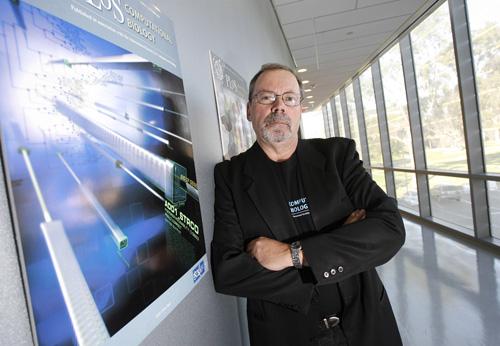Video-sharing sites bringing science to public eye

Dr. Phillip Bourne, creator of video-sharing site SciVee.com, poses outside his lab at the University of California, San Diego Thursday, Nov. 15, 2007 in San Diego. Bourne, a pharmacologist at UCSD, wanted a reputable virtual place where researchers coul Denis Poroy, The Associated Press
Dec 6, 2007
LOS ANGELES – Haim Weizman is a chemist by trade and an Internet moviemaker on the side.
In his first video, a telegenic narrator in a lab coat swirls a flask as electronic music plays in the background. Created by four science and film students at the University of California, San Diego, the video shows a typical recrystallization experiment straight out of Chemistry 101.
The six-minute epic complete with bloopers got 1,205 views on Google Inc.’s YouTube, but the number increased fourfold when the video was posted to SciVee, one of a number of online video-sharing startups designed to let scientists broadcast themselves toiling in the laboratory or delivering lectures.
Fans of the niche sites say they help the lay public – and students – understand the scientific process, allow researchers to duplicate one another’s results and may help discourage fraud.
“Anyone in an organic chemistry class anywhere can now perform this experiment by watching the video. There are so many details that it’s hard to describe in a lab manual,” said Weizman, a lecturer at UC San Diego. He went on to produce five more lab-training videos.
Get The Daily Illini in your inbox!
Researchers who are uploading their experiments and lectures online are discovering filmmaking is more art than science. If the narrators are boring or the image is shaky, viewers will quickly learn to click elsewhere.
“Scientists are not moviemakers so getting them to shoot their experiments and describe them properly can be a challenge,” said Anton Denissov, a video analyst with the Yankee Group.
Funded by the National Science Foundation, SciVee encourages scholars with a paper hot off the press to make a short video called a “pubcast” highlighting the key points. It also accepts submissions that have no connection to any published work.
Phil Bourne, a pharmacologist at UC San Diego, launched SciVee this summer after seeing his students hooked on YouTube. Bourne wanted a reputable virtual place where researchers could trade techniques without the potpourri of topics found on general video-sharing sites.
“It’s quite a quantum leap for scientists to present their research in this way,” Bourne said.
The age-old practice of reporting scientific results in peer-reviewed journals or at scientific conferences isn’t going away soon. Most journals with online editions are taking a wait-and-see approach about YouTube-type videos, although many routinely add podcasts and other media to accompany papers.
“This is an area we’re extremely interested in, but we’re still in the embryonic stage,” said Stewart Wills, online editor of the journal Science.
One of the startup sites – called JoVE, short for the Journal of Visualized Experiments – is the digital mirror to traditional scientific journals, however.
JoVe editor-in-chief Moshe Pritsker said he once flew to Scotland for a week just to see how a research group performed an embryonic stem cell technique. He couldn’t help but wonder if there were an easier way than jetting across the Atlantic Ocean.
Some experts say the biggest advantage to science videos is making research more accessible to nonscientists.
And translating the experiments to video won’t be without challenges. Chief among them is attracting enough Web traffic to make the sites profitable. Even combined, the science video sites attract an extremely small group compared to YouTube, which drew 48.5 million U.S. visitors in October, according to comScore Inc.
Weizman, the UC San Diego chemist, approaches each video he makes through the eyes of his students.
“I have a little picture in my mind of what I want to see,” he said. “That makes a huge difference.”





